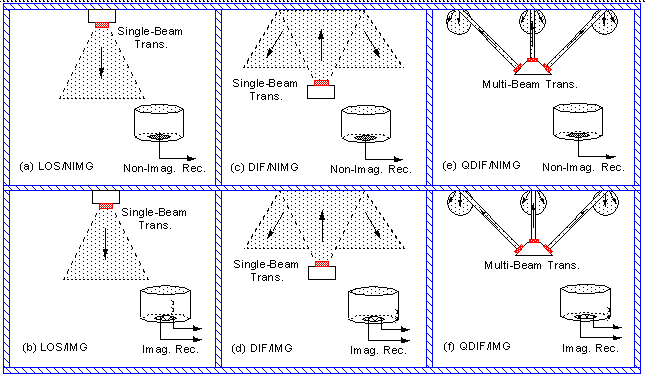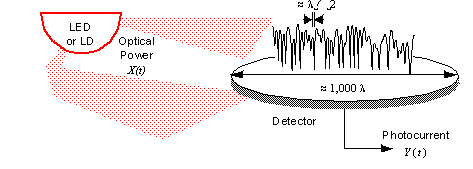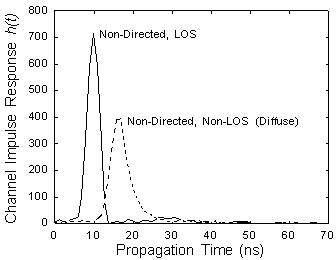
 |
Wireless Communication
Chapter: Network Concepts and Standards
|

Traditionally, wireless infrared links have been classified according to whether they employ directional or non-directional transmitters and receivers, and whether or not they rely upon the existence of an uninterrupted line-of-sight path between the transmitter and the receiver. Non-directed, non-line-of-sight, or diffuse infrared links behave much like radio links, and are used in several commercially available in-building wireless LANs.
 Due to multipath propagation, the envelope of the received field is subject to fluctuations on the sub wavelength scale, as in a multipath radio system. However, the large square-law photodetector provides high-order spatial diversity, eliminating multipath fading, i.e., the drastic changes in signal magnitude and phase that accompany movement of the antenna by a fraction of a wavelength. The existence of multiple paths between the transmitter and receiver does lead to multipath distortion, which can be modeled accurately as a linear, time-invariant system, in which the powers of the different paths add incoherently.
Multipath distortion is observed in non-directed links, and typical channels exhibit r.m.s. delay spreads up to a few tens of nanoseconds, depending on the room size.
Due to multipath propagation, the envelope of the received field is subject to fluctuations on the sub wavelength scale, as in a multipath radio system. However, the large square-law photodetector provides high-order spatial diversity, eliminating multipath fading, i.e., the drastic changes in signal magnitude and phase that accompany movement of the antenna by a fraction of a wavelength. The existence of multiple paths between the transmitter and receiver does lead to multipath distortion, which can be modeled accurately as a linear, time-invariant system, in which the powers of the different paths add incoherently.
Multipath distortion is observed in non-directed links, and typical channels exhibit r.m.s. delay spreads up to a few tens of nanoseconds, depending on the room size.

Since a photodetector produces a current proportional to the received optical power, the SNR of IM/DD links is proportional to the square of the received optical power. As a result, the effective decrease in SNR due to propagation is twice the path loss (in decibels), which limits the transmission range of infrared links using non-directional transmitters.
 Achievement of a high SNR requires a large effective light-collection area. It is desirable to minimize the actual detector area, because the capacitance associated with a large-area detector can limit the receiver bandwidth and increase its noise. Fortunately, the receivers effective area can be increased by using an optical concentrator. A concentrator having refractive index n and acceptance half-angle theta can achieve an optical gain as high as
Achievement of a high SNR requires a large effective light-collection area. It is desirable to minimize the actual detector area, because the capacitance associated with a large-area detector can limit the receiver bandwidth and increase its noise. Fortunately, the receivers effective area can be increased by using an optical concentrator. A concentrator having refractive index n and acceptance half-angle theta can achieve an optical gain as high as
2 2 n csc(theta).Thus, the optical gain can be increased dramatically by reducing the acceptance angle. Non-imaging hemispherical lenses provide an omnidirectional gain of n2, making them suitable for non-directed links. If a bandpass filter is placed on the surface of a hemispherical lens, all rays striking the detector hit the filter near normal incidence, making it possible to achieve high gain, wide FOV and narrow passband simultaneously. A hemispherical lens-bandpass filter combination has been used in a prototype 50-Mb/s diffuse infrared link.